ATI EXIT EXAM CORRECT AND VERIFIED STUDY GUIDE
Document Content and Description Below
ATI EXIT EXAM CORRECT AND VERIFIED STUDY GUIDE 1. While assessing a client with diabetes mellitus, the nurse observes an absence of hair growth on the client's legs. What additional assessment provide... s further data to support this finding? 2. The healthcare provider prescribes 15 mg/kg of Streptomycin for an infant weighing 4 pounds. The drug is diluted in 25 ml of D5W to run over 8 hours. How much Streptomycin will the infant receive? 3. In assessing a client with preeclampsia who is receiving magnesium sulfate, the nurse determines that her deep tendon reflexes are 1+; respiratory rate is 12 breaths/minute; urinary output is 90 ml in 4 hours; magnesium sulfate level is 9 mg/dl. Based on these findings, what intervention should the nurse implement 4. A client is on a mechanical ventilator. Which client response indicates that the neuromuscular blocker tubocurarine chloride (Tubarine) is effective? 5. An elderly female client comes to the clinic for a regular check-up. The client tells the nurse that she has increased her daily doses of acetaminophen (Tylenol) for the past month to control joint pain. Based on this client's comment, what previous lab values should the nurse compare with today's lab report 6. Aspirin is prescribed for a 9-year-old child with rheumatic fever to control the inflammatory process, promote comfort, and reduce fever. What intervention is most important for the nurse to implement 7. Which signs or symptoms are characteristic of an adult client diagnosed with Cushing's syndrome? 8. A charge nurse agrees to cover another nurse’s assignment during a lunch break. Based on the status report provided by the nurse who is leaving for lunch, which client should be checked first by the charge nurse? The client 9. An outcome for treatment of peripheral vascular disease is, "The client will have decreased venous congestion." What client behavior would indicate to the nurse that this outcome has been met? 10. The healthcare provider performs a paracentesis on a client with ascites and 3 liters of fluid are removed. Which assessment parameter is most critical for the nurse to monitor following the procedure? 11. The nurse is administering sevelamer (RenaGel) during lunch to a client with end stage renal disease (ESRD). The client asks the nurse to bring the medication later. The nurse should describe which action of RenaGel as an explanation for taking it with meals? 12. The nurse formulates a nursing diagnosis of, "High risk for ineffective airway clearance" for a client with myasthenia gravis. What is the most likely etiology for this nursing diagnosis? 13. Following a CVA, the nurse assess that a client developed dysphagia, hypoactive bowel sounds and firm, distended abdomen. Which prescription for the client should the nurse question? 14. A client's telemetry monitor indicates the sudden onset of ventricular fibrillation. Which assessment finding should the nurse anticipate? 15. In assessing a 70-year-old female client with Alzheimer's disease, the nurse notes that she has deep inflamed cracks at the corners of her mouth. What intervention should the nurse include in this client's plan of care?16. A young adult female client is seen in the emergency department for a minor injury following a motor vehicle collision. She states she is very angry at the person who hit her car. What is the best nursing response 17. An 85-year-old male resident of an extended care facility reaches for the hand of the unlicensed assistive personnel (UAP) and tries to kiss her hand several times during his morning care. The UAP reports the incident to the charge nurse. What is the best assessment of the situation? 18. The parents of a newborn infant with hypospadias are concerned about when the surgical correction should occur. What information should the nurse provide? 19. In evaluating teaching of a client about wearing a Holter monitor, which statement made by the client would indicate to the nurse that the client understands the procedure? 20. A 9-year-old female client was recently diagnosed with diabetes mellitus. Which symptom will her parents most likely report? 21. The nurse is caring for four clients: Client A, who has emphysema and whose oxygen saturation is 94%; Client B, with a postoperative hemoglobin of 8.7 mg/dl; Client C, newly admitted with a potassium level of 3.8 mEq/L; and Client D, scheduled for an appendectomy who has a white blood cell count of 15,000 mm3. What intervention should the nurse implement? 22. A recently widowed middle-aged female client presents to the psychiatric clinic for evaluation and tells the nurse that she has "little reason to live." She describes one previous suicidal gesture and admits to having a gun in her home. To maintain the client's confidentiality and to help ensure her safety, which action is best for the nurse to implement? 23. It is most important for the registered nurse (RN) who is working on a medical unit to provide direct supervision in which situation? 24. A nurse is completing the health history for a 25-year-old male client who reports that he is allergic to penicillin. Which question should the nurse ask after receiving this information? 25. A 10-year-old child with meningitis is suspected of having diabetes insipidus. In evaluating the child's laboratory values, which finding is indicative of diabetes insipidus? 26. A client with myelogenous leukemia is receiving an autologous bone marrow transplantation (BMT). What is the priority intervention that the nurse should implement when the bone marrow is repopulating? 27. A 38-year-old male client collapsed at his outside construction job in Texas in July. His admitting vital signs to ICU are, BP 82/70, heart rate 140 beats/minute, urine output 10 ml/hr, skin cool to the touch. Pulmonary artery (PA) pressures are, PAWP 1, PAP 8/2, RAP -1, SVR 1600. What nursing action has the highest priority? 28. A client who has Type 1 diabetes and is at 10-weeks gestation comes to the prenatal clinic complaining of a headache, nausea, sweating, feeling shaky, and being tired all the time. What action should the nurse take first? 29. A client in labor states, "I think my water just broke!" The nurse notes that the umbilical cord is on the perineum. What action should the nurse perform first? 30. The nurse is planning care for a non-potty-trained child with nephrotic syndrome. Which intervention provides the best means of determining fluid retention? 31. The mother of a 9-month-old who was diagnosed with respiratory syncytial virus (RSV) yesterday calls the clinic to inquire if it will be all right to take her infant to the first birthday party of a friend's child the following day. What response should the nurse provide this mother? 32. A client from a nursing home is admitted with urinary sepsis and has a single-lumen, peripherally-inserted central catheter (PICC). Four medications are prescribed for 9:00 a.m. and the nurse is running behind schedule. Which medication should the nurse administer first? 33. Which action should the nurse implement to reduce the risk of vesicant extravasation in the client who is receiving intravenous chemotherapy 34. An elderly male client reports to the clinic nurse that he is experiencing increasing nocturia with difficulty initiating his urine stream. He reports a weak urine flow and frequent dribbling after voiding. Which nursing action should be implemented? 35. The nurse is performing an admission physical assessment of a newborn who is small for gestational age (SGA). Which finding should the nurse report immediately to the pediatric healthcare provider? 36. Which client's laboratory value requires immediate intervention by a nurse? 37. In planning the turning schedule for a bedfast client, it is most important for the nurse to consider what assessment finding? 38. The healthcare provider prescribes naproxen (Naprosyn) 500 mg PO twice a day for a client with osteoarthritis. During a follow-up visit one month later, the client tells the nurse, "The pills don't seem to be working. They are not helping the pain at all." Which factor should influence the nurse's response? 39. A nurse is interested in studying the incidence of infant death in a particular city and wants to compare that city's rate to the state's rate. What state resource is most likely to provide this information 40. A 60-year-old male client is admitted to the hospital with the complaint of right knee pain for the past week. His right knee and calf are warm and edematous. He has a history of diabetes and arthritis. Which neurological assessment action should the nurse perform for this client? 41. A highly successful businessman presents to the community mental health center complaining of sleeplessness and anxiety over his financial status. What action should the nurse take to assist this client in diminishing his anxiety? 42. What physical assessment data should the nurse consider a normal finding for a primigravida client who is 12 hours postpartum? 43. The nurse plans to educate a client about the purpose for taking the prescribed antipsychotic medication clozapine (Clozaril). Which statement should the nurse provide? 44. A male client is admitted to the neurological unit. He has just sustained a C-5 spinal cord injury. Which assessment finding of this client warrants immediate intervention by the nurse 45. A male infant born at 30-weeks gestation at an outlying hospital is being prepared for transport to a Level IV neonatal facility. His respirations are 90/min, and his heart rate is 150 beats per minute. Which drug is the transport team most likely to administer to this infant? 46. Because the census is currently low in the Obstetrics (OB) unit, one of the nurses is sent to work on a medical-surgical unit for the day, or until the OB unit becomes busy. Which client assessment is best for the charge nurse to assign to the OB nurse? 47. A primipara at 38-weeks gestation is admitted to labor and delivery for a biophysical profile (BPP). The nurse should prepare the client for what procedures? 48. A male client who is in the day room becomes increasingly angry and aggressive when he is denied a day-pass. Which action should the nurse implement? 49. A client is discussing feelings related to a recent loss with the nurse. The nurse remains silent when the client says, "I don't know how I will go on." What is the most likely reason for the nurse's behavior? 50. An unlicensed assistive personnel (UAP) reports to the charge nurse that a client who delivered a 7-pound infant 12 hours ago is complaining of a severe headache. The client's blood pressure is 110/70, respiratory rate is 18 breaths/minute, heart rate is 74 beats/minute, and temperature is 98.6º F. The client's fundus is firm and one fingerbreadth above the umbilicus. What action should the charge nurse implement first? 51. In developing a care plan for a client that has a chest tube due to a hemothorax, the nurse should recognize that which intervention is essential? 52. Immediate postoperative nursing care for a client who has had a surgical repair of an abdominal aortic aneurysm should include which interventions 53. A nurse is teaching a client postoperative breathing techniques using an incentive spirometer (IS). What should the nurse encourage this client to do to maintain sustained maximal inspiration 54. A 65-year-old female client arrives in the emergency department with shortness of breath and chest pain. The nurse accidentally administers 10 mg of morphine sulfate instead of 4 mg as prescribed by the healthcare provider. Later, the client's respiratory rate is 10 breaths/minute, oxygen saturation is 98%, and she states that her pain has subsided. What is the legal status of the nurse? 55. A client with which problem requires the most immediate intervention by the nurse? 56. The charge nurse should intervene when what behavior is observed? 57. Which assessment finding indicates a client's readiness to leave the nursing unit for a bronchoscopy 58. The nurse is planning care for a 16-year-old, who has juvenile rheumatoid arthritis (JRA). The nurse includes activities to strengthen and mobilize the joints and surrounding muscle. Which physical therapy regimen should the nurse encourage the adolescent to implement 59. An 89-year-old male client complains to the nurse that people are whispering behind his back and mumbling when they talk to him. What age-related condition is likely to be occurring with this client? 60. A client with a cold is taking the antitussive benzonatate (Tessalon). Which assessment data indicates to the nurse that the medication is effective? 61. The community mental health nurse is planning to visit four clients with schizophrenia today. Which client should the nurse see first ..............................CONTINUED.........................................................DOWNLOAD FOR THOROUGH REVISION FOR BEST SCORES [Show More]
Last updated: 1 year ago
Preview 1 out of 37 pages
Instant download

Buy this document to get the full access instantly
Instant Download Access after purchase
Add to cartInstant download
Reviews( 0 )
Document information
Connected school, study & course
About the document
Uploaded On
May 16, 2021
Number of pages
37
Written in
Additional information
This document has been written for:
Uploaded
May 16, 2021
Downloads
0
Views
44

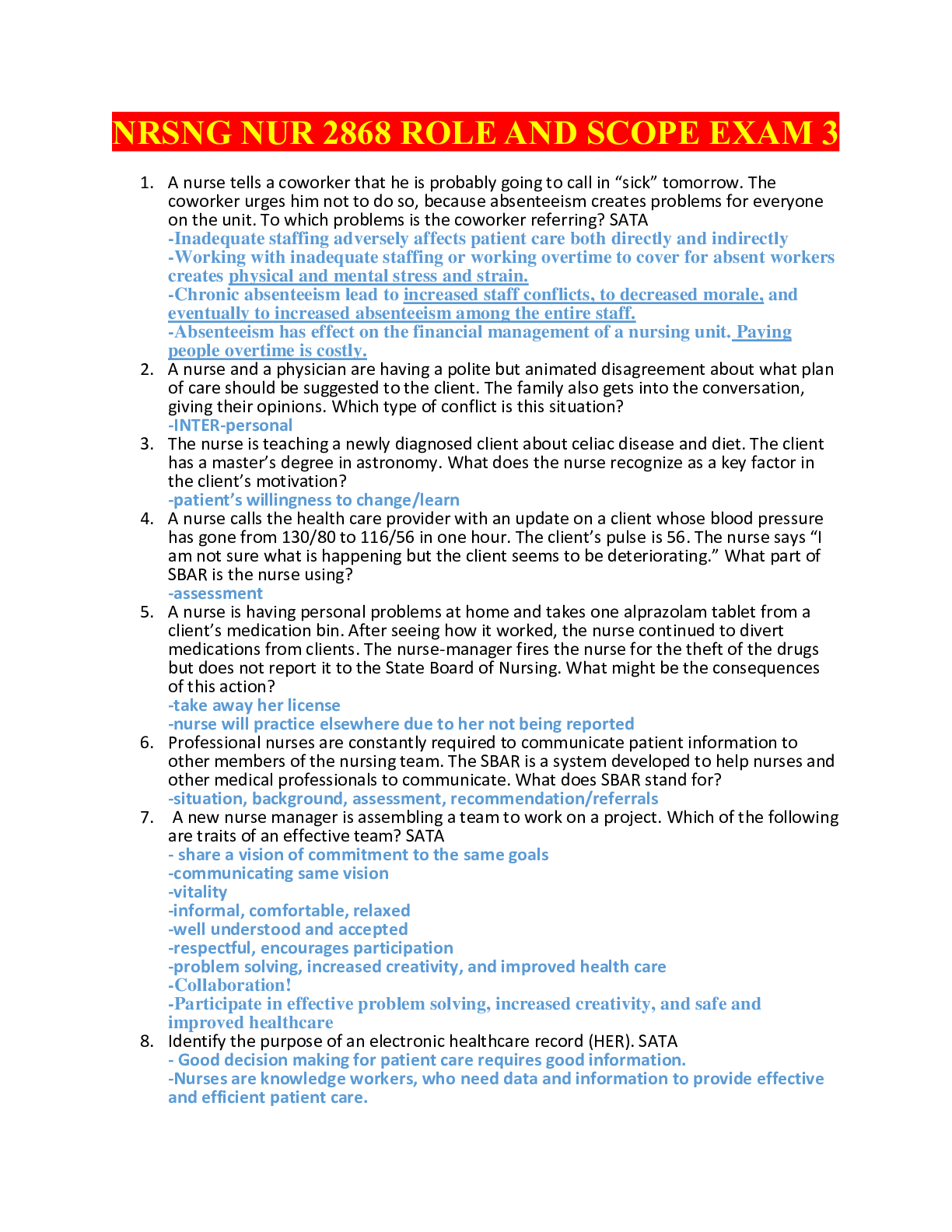

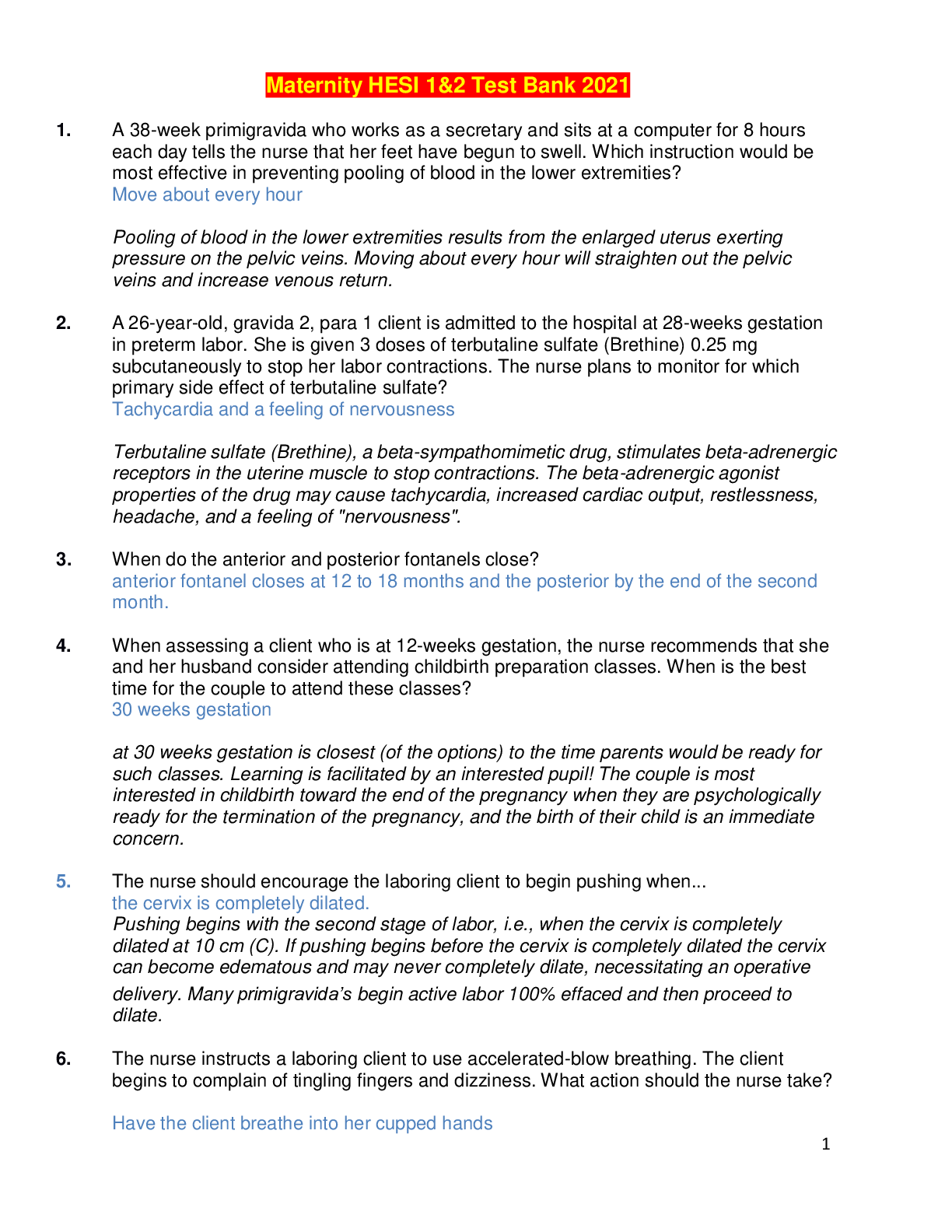
.png)
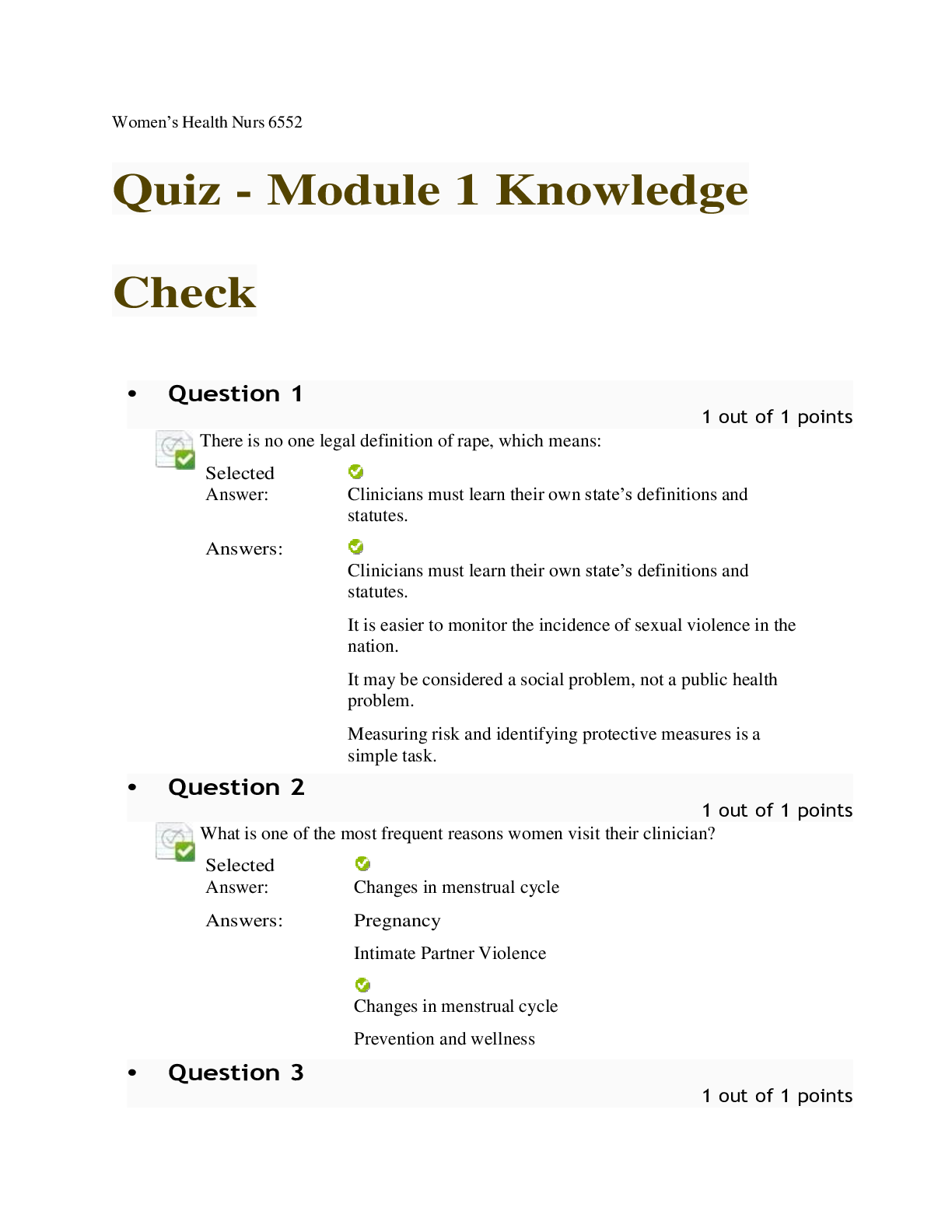
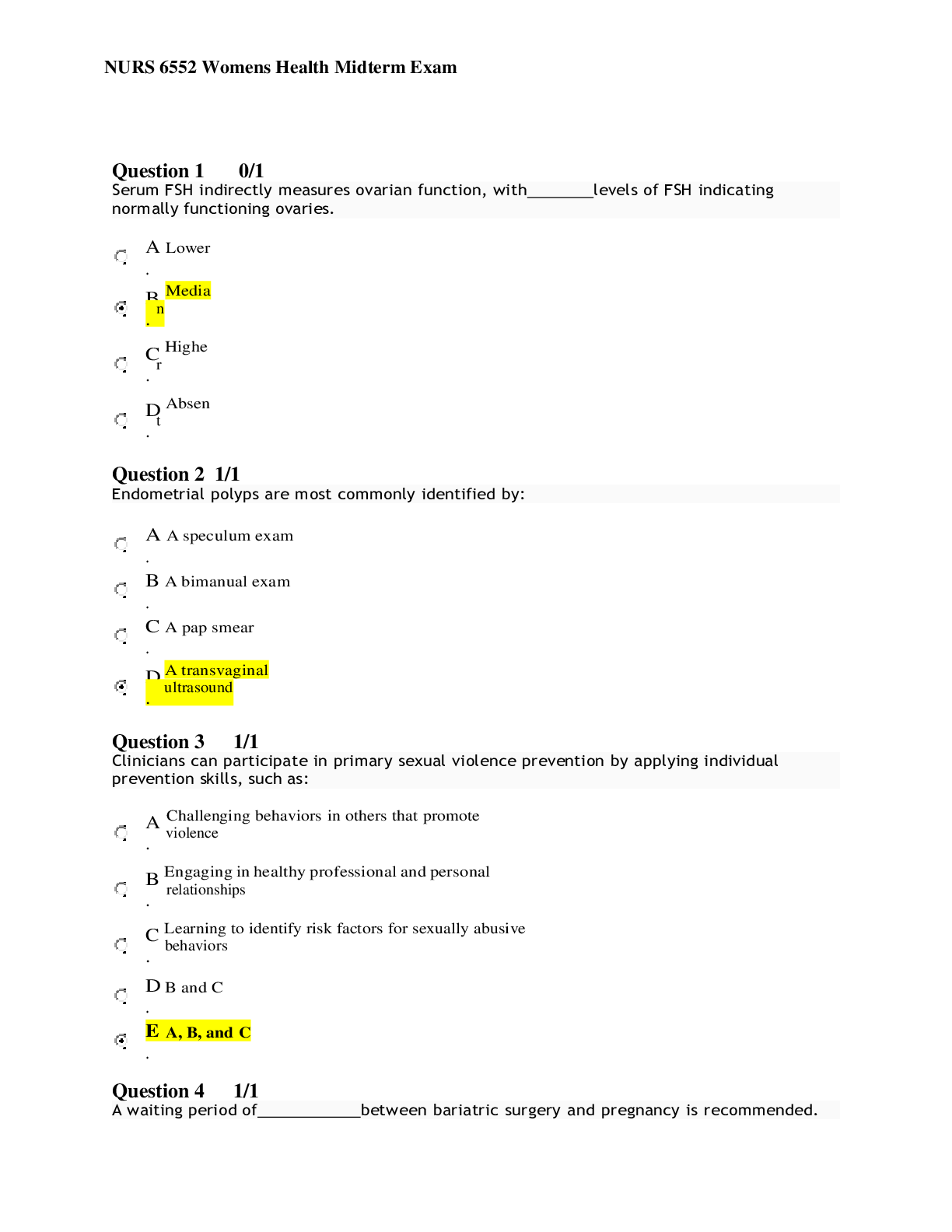


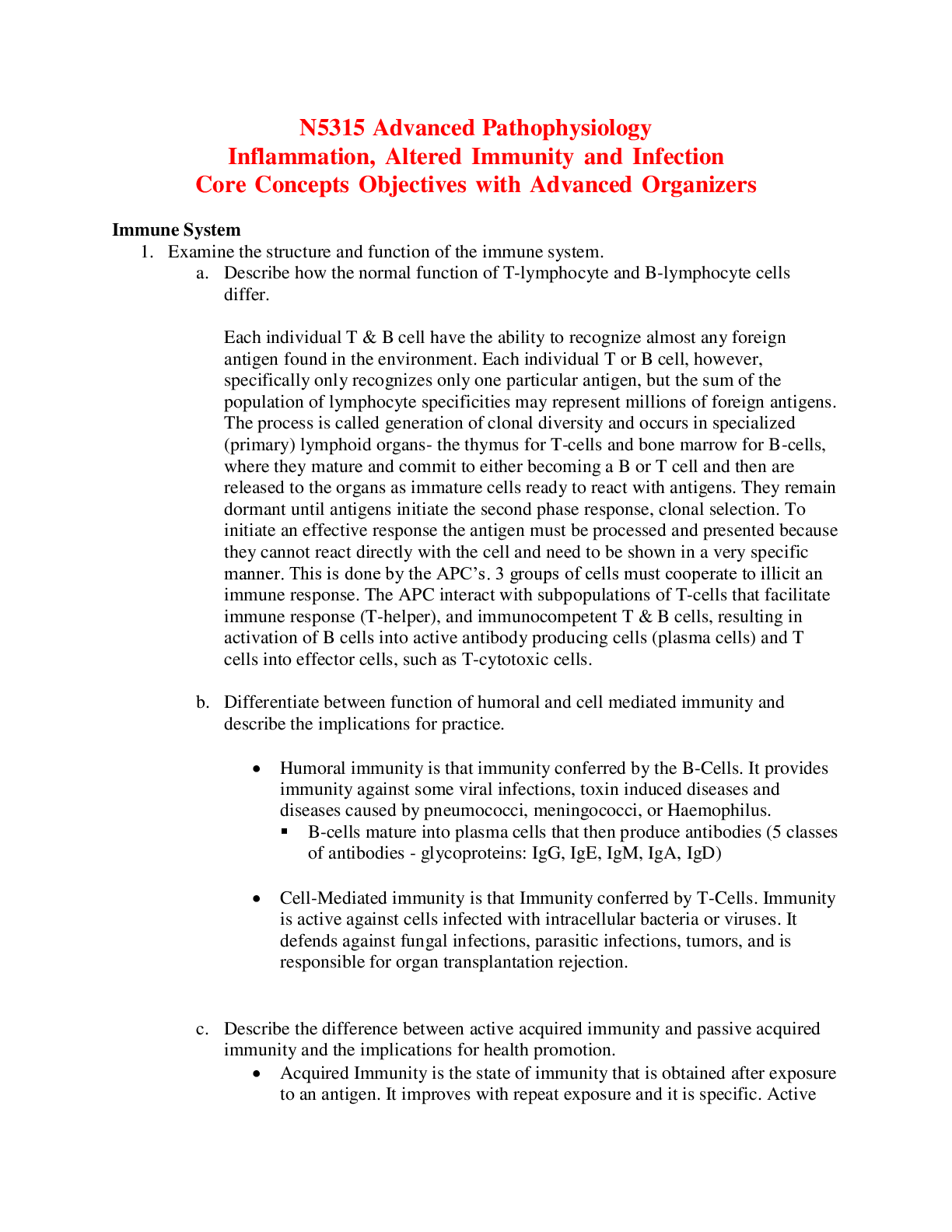

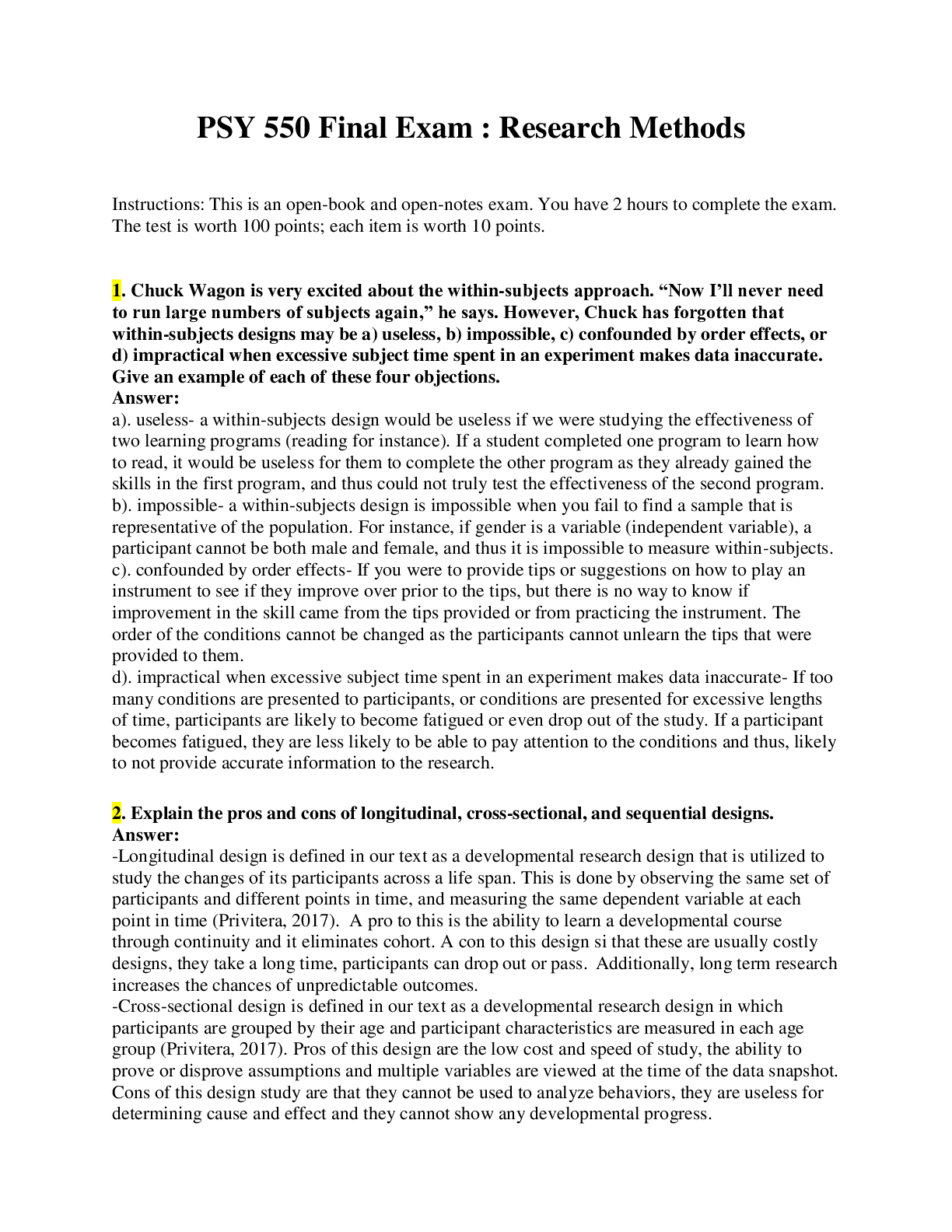

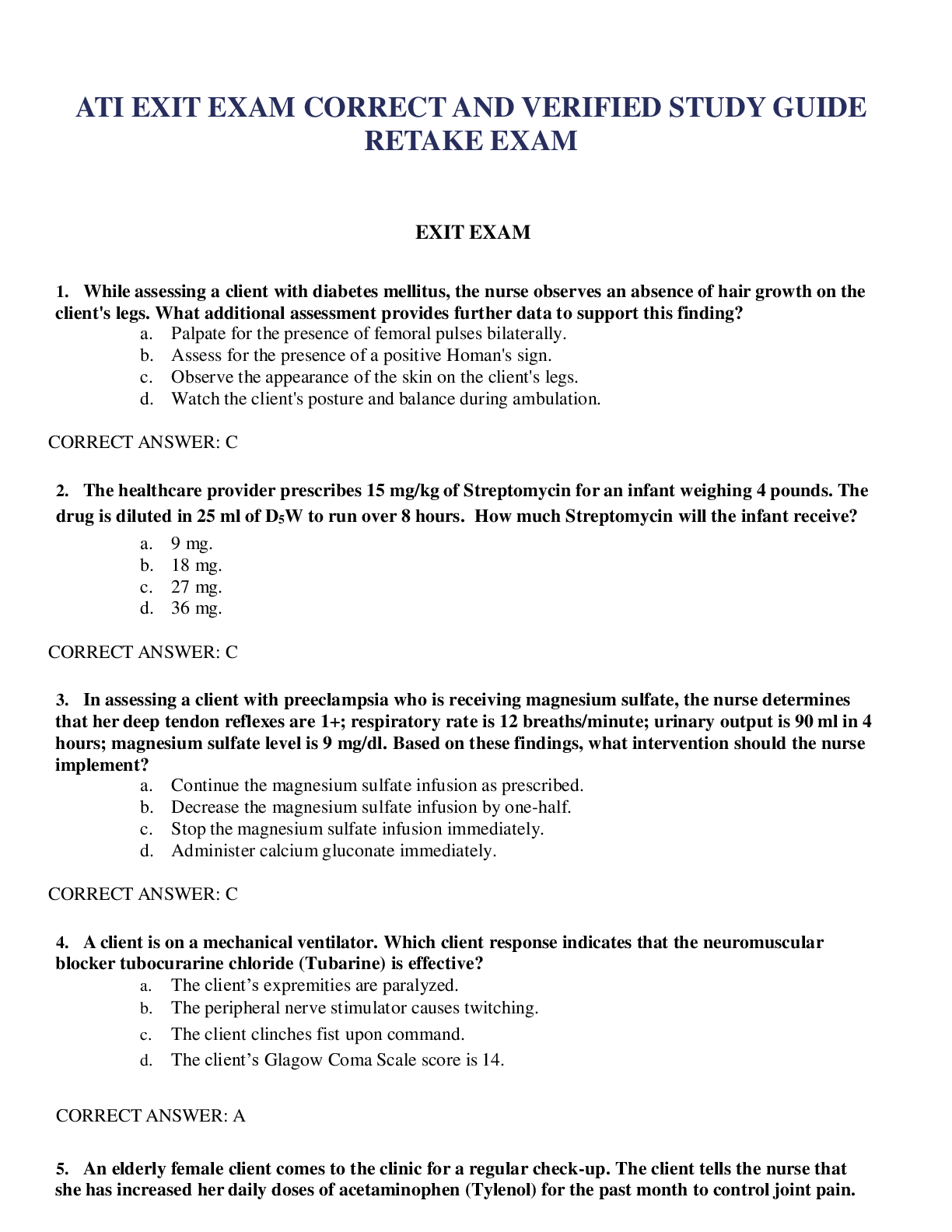
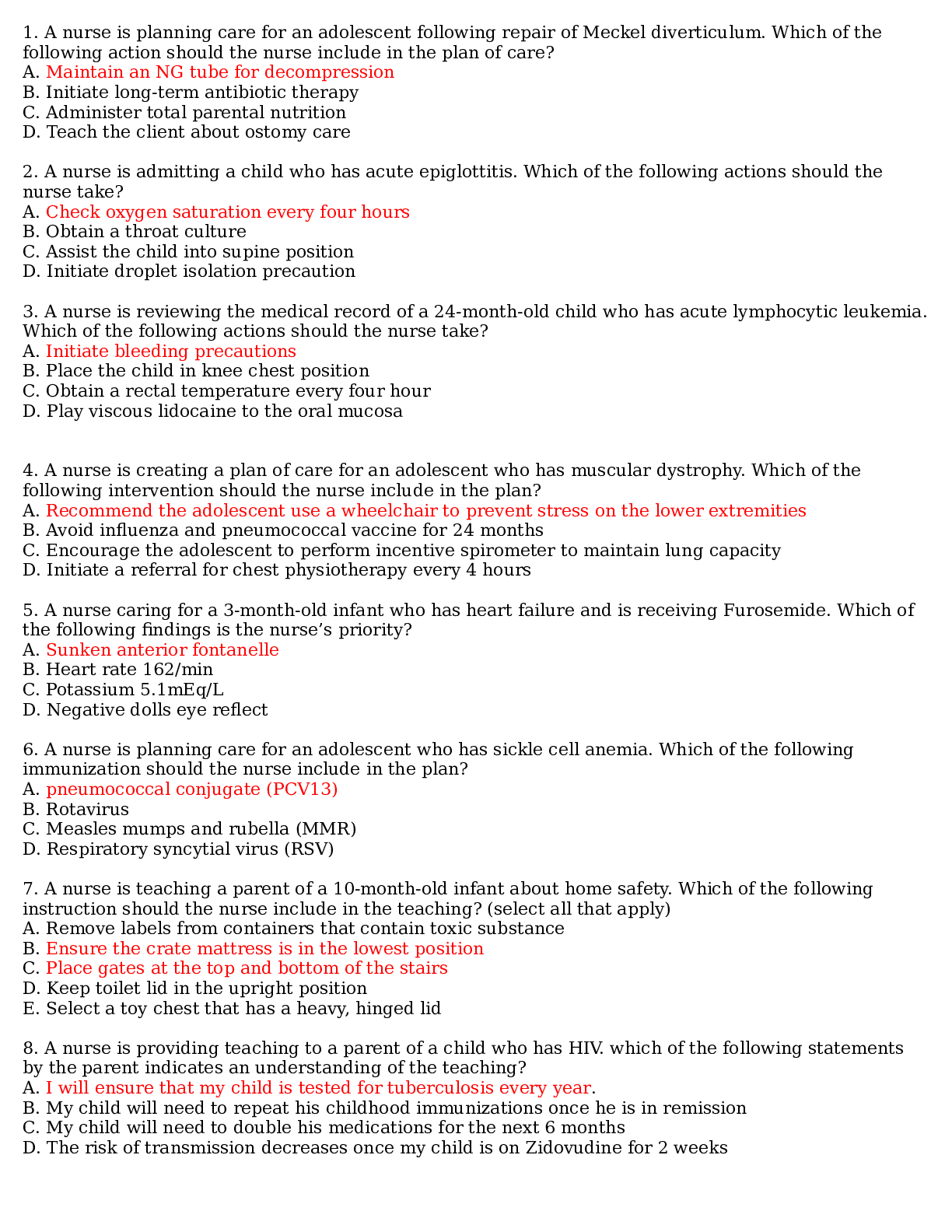

.png)

